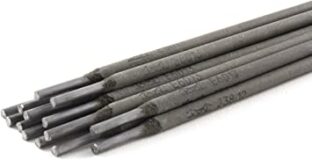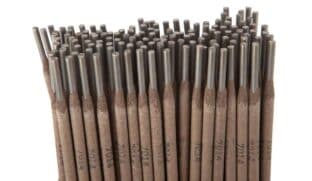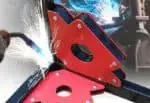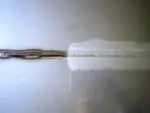With so many different types of welding rods or electrodes as they are called, it can be confusing to figure out which is the best one or the easiest one to use. However, after doing a great deal of research and experimentation at our end, I have come to realize that the E7018 is by far the easiest one to use.
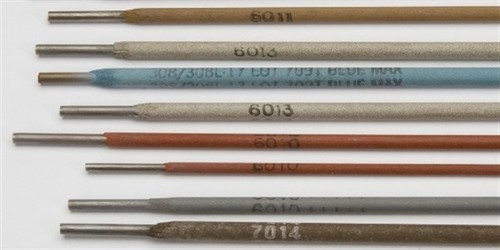 By the end of this article, you will have a better understanding of which welding rod to use for your own welding project. I have covered every aspect of welding rods for your knowledge so that you do not have to spend hours cramming for information from different websites.
By the end of this article, you will have a better understanding of which welding rod to use for your own welding project. I have covered every aspect of welding rods for your knowledge so that you do not have to spend hours cramming for information from different websites.
Let me first brief you on the different types of welding rods that exist and what the letter and numbers signify
There are hundreds and thousands of welding rods that exist, out of which the following are the most commonly and popularly used – E6010, E6011, E6012, E6013, E7014, E7018, and E7024. They fall under the AWS (American Welding Society) A5.1 Specification for Carbon Steel Electrodes for Shielded Metal Arc Welding.
There is a standard classification system that AWS uses to determine the properties of a stick electrode. I will break it down for you, so you have more clarity on how these numbers classify the electrode. You will notice letters and numbers engraved on the side of every electrode and each of them has a meaning to it.
-
-
- It always starts with the letter E which stands for Electrode.
- Then the first two digits that follow represent the minimum tensile strength of the resulting weld.
- The electrodes welding position usage is determined by the third number.
- Each electrode can be used for a type of coating and welding current, which is determined by the fourth and final number.
-
Below is a description on each type of electrode or welding rod that is popularly used by welders
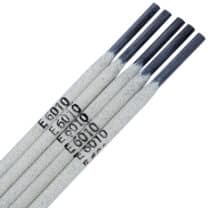 E6010: This type of welding rod can be used in any welding position. Such as vertical, horizontal, flat, or overhead. However, only direct current or DC power sources are suitable for using this electrode.
E6010: This type of welding rod can be used in any welding position. Such as vertical, horizontal, flat, or overhead. However, only direct current or DC power sources are suitable for using this electrode.
So, this becomes sort of a limit on it. It can easily pass through deeply into the metal and gouge through oil, dirt, rust, and paint. It is a fast freeze welding rod, which means that it cools down much faster than most electrodes by preventing the puddle from getting too hot, too quickly.
They should always be stocked in an airtight container that is kept in a dry place in room temperature. These electrodes are best for pipe welding, shipyards, steel castings, steel storage tanks, water towers, and field constructions.
One major drawback of this welding rod is its immensely tight arc which makes it difficult to be used by a beginner in welding.
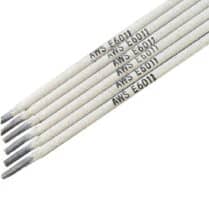 E6011: This welding rod is more or less the same as the E6010 with one major difference, it is suitable with both AC or alternating current and DC power sources.
E6011: This welding rod is more or less the same as the E6010 with one major difference, it is suitable with both AC or alternating current and DC power sources.
Due to its versatility, welders find it very convenient to shift from one type of current to the other depending on the requirement for the work. A lot of welders use it for maintenance and repair-related welding work.
Similar to the E6010 this welding rod also can penetrate deep into the metal and works perfectly on mild steel to the regular ones. For welding thick metals, the E6011 is probably the ideal option. Plus, it works great on surfaces that have paint, dirt, and grease. Since this is also a fast freeze rod, it is amazing for welding pipes and root bases.
If you are working on something that requires an artistic finish then this electrode’s disadvantage of leaving behind wrinkles and a rugged finishing will surely be a disappointment. This happens due to it creating flat weld beads.
E6012: This general function welding rod is again adaptable with both types of currents, which are AC and DC power sources. It works outstandingly for bridging gaps between two joints which is one of its main usages.
It produces very minimum sprinkles while performing at a high speed and also yields a highly stable arc. Making it quite popular among professional welders.
This type of welding rod works great when you have to connect open joints, non-critical welding, repair work with welding, and corroded carbon steel sheet welding.
There are two major drawbacks of this electrode – it creates shallow or thin penetration, and additional cleaning is needed after welding because the smelting produces thick waste material.
See also: Does Stainless Steel Weld on AC or DC? (Solved!)
E6013: Similar to the 6011 and 6012, this welding rod is also suitable for both AC and DC power sources. It is a good option for beginners or inexperienced welders. This electrode can also work in any type of position like the above three electrodes.
It is known for producing a soft arc with scanty splatter, hence, there is no additional cleaning after the welding. It has a conveniently detachable slag and is mostly applied when mild or medium penetration is required on thin metals.
Considering all its features, and the fact that it generates quite a substantial and smooth arc or weld appearance, it is an excellent option for applications in need of a position change. Plus, for situations that implicate short or even irregular welding projects, this electrode works great.
They should be particularly used for welding clean and new sheet metals, building and repairing ships, and also worn-out mild steel exterior.
E7014: This type of welding rods are used on low-alloy and carbon steels, and are a great option for horizontal applications. They are quite similar to the E6012 when it comes to producing the same joint penetration.
There is an increase in the deposition rate because this electrode consists of a greater quantity of iron powder. When we compare it to the E6012 these electrodes can be operated at higher amperages. This electrode will give you a very smooth finish and you will have very little to clean once welding is done.
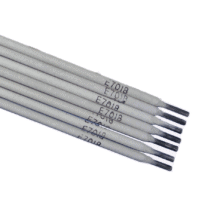 E7018: This welding rod is devised to give you an extremely strong weld that can endure up to 70,000 psi of pressure per square inch. It consists of a thick flux, along with a high iron powder content that is fundamentally used for welding carbon steel that ranges from low to moderate.
E7018: This welding rod is devised to give you an extremely strong weld that can endure up to 70,000 psi of pressure per square inch. It consists of a thick flux, along with a high iron powder content that is fundamentally used for welding carbon steel that ranges from low to moderate.
It is definitely one of the most adaptable electrodes out of the lot. The welding rod is glazed with a low-hydrogen compound made of iron, which is what actually vaporizes and prevents the weld bead from getting tarnished by air and moisture.
Welders use this electrode for structural welding and are often referred to as its backbone, as it releases minimal spatter with a medium arc infiltration while creating a very slick quiet arc. It can be used in all four positions and is suitable for both AC and DC power sources.
This type of electrode is mainly used for welding in powerhouses, factories, energy power plants, and bridges. This rod should not be exposed to humidity or dampness for it to function efficiently. So it has to be kept dry at all times, and if it does get damp then it is best to dry it in a rod oven prior to using it.
Hence, the E7018 electrode has proven itself to be the most versatile rod out of all the others mentioned here and is the smoothest and easiest to use for welding.
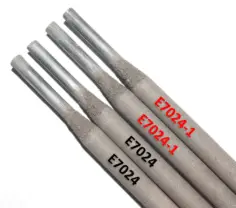 E7024: This electrode is best used by welders for high-speed flat fillet or horizontal welds, because of its high iron powder content which increases the deposition rate. This in particular aids in making the welding easier.
E7024: This electrode is best used by welders for high-speed flat fillet or horizontal welds, because of its high iron powder content which increases the deposition rate. This in particular aids in making the welding easier.
E7024 electrode works best for applications that need a fine sleek finish. You do need to have a clean material surface to work on with this electrode.
Steel plates that are at least ¼ inch thick and metals measuring over ½ inch thick, these electrodes function very well on them. Similar to the E7018, this electrode also gives you a smooth bead with mild penetration.
Why is the E7018 welding rod easiest to use?
As mentioned above in the description of the E7018, it is one of the most preferred electrodes among professional welders due to its versatility, high iron powder content, thick flux, tensile strength, and ability to produce a very smooth arc.
All of these features, characteristics, and functions make it the easiest rod to be used for welding applications.
How you should choose the right welding rod or electrode for your welding application?
1.) The composition of the base metal is of utmost importance because the welding rod should match the base metal. This will help you in getting a sturdy and strong weld at the end.
2.) You should also check the tensile strength of both the base metal and welding rod as they must match as well. Otherwise, there may be cracks in the welds.
3.) The power source needs to be checked too when picking a welding rod because some of the electrodes are compatible with both AC and DC power sources, while some are not.
These are the few basic pointers that you should keep in mind at all times to help you choose the appropriate welding rod.
Wrapping up
Choosing the right electrode to complete your welding job is not the toughest thing. You simply need to be aware of your welding application requirements before commencing the job.
I hope this article has been helpful in giving you the information you require and lead you in the right direction. Happy welding!

